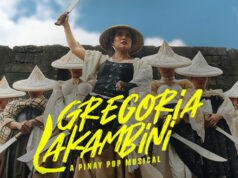Nina Aguas furnishes her home with souvenirs.
INTERVIEW CAMILLE ANNE M. ARCILLA | PHOTOGRAPHY JONATHAN BALDONADO
Nina D. Aguas, chief executive officer of The Insular Life Assurance Company, Ltd., believes in bringing home a part of her journey. Bits and pieces of her travels have accreted in in her abode — a few of them small, such as photographs of her apple-picking in New York back in 2007, a few of them big as Mexican mesquite furniture.
Her Mexican-Moroccan-Spanish-themed home is a scrapbook that opens with a blue vintage wooden door from India. In her living room, there’s a wooden table from Bali, paintings from Vietnam, and a tapestry from France. In a corner, there is a closet full of Japanese dolls called ningyo. Her collection consists of traditional geishas, Harajukus, Kokeshis, and Saga dolls. Ms. Aguas took out an antique pair of wooden Kokeshis with hunched backs and introduced them as “her grandparents.”

Why are these two dolls special for you?
I went back to buy them in an antique shop in Tokyo. Two elderly ones. When I saw them at the store, I thought, very few people stop and look at their grandparents. I’ve never seen my grandparents. My grandfather and grandmother, I have no fond memories of them. I never remember seeing my grandma, so why not? Why not take them home? They’re a bit pricey, but… aren’t they cute?
When did you start collecting Japanese dolls?
Oh, God, if I tell you, you’ll know how old I am. (laughs) I was visiting Japan and I saw some of their unique dolls. They really dress them up in kimonos and other things. But then there are these wooden dolls, which are more affordable.
Every time I pass by Japan on the way to New York or to another country, I pick up a couple of my favorites. And then friends found out that I collected dolls, so they thought they would add. The story goes on.
Some I picked up from Hawaii. To summarize the history of Hawaii: when the Japanese went to Hawaii to work in farms, they brought these dolls with them. You see some of them in antique shops. I find them very interesting so I just close my eyes and buy them.
Do you keep track of how many Japanese dolls you have now?
I don’t count because I have too many.
Which of these Japanese dolls would you want to look like?
I’d like to be one of those Geishas, with all the white chalk on your face. No one will recognize you. (laughs) But really, what I like about the Geisha doll is the kimono. It’s so intricate, so beautiful.
Your house tells so many stories.
That’s why I keep saying that it’s a fusion of Moroccan, Mexican, Filipino or whatever. We wanted to be free when we designed this house. We had a French-inspired house before, but we decided to do this.
When I was with Citibank, I was responsible for the whole Asia Pacific — Australia, New Zealand, Thailand, Indonesia, Malaysia, Singapore, Hong Kong, Taiwan, Korea, the Philippines, of course, Guam, and Japan. I was traveling for about 70% of the time. It was hard, but I enjoyed it.
Souvenirs are like bringing home a part of [each country] with you, but I think nothing is more important than what you bring back with you in your heart.
How did you get to Insular from Citibank?
I spent 26 years with Citibank and I came back. Then I was headhunted by an Australian bank, the Australia and New Zealand Banking Group Limited, where I headed the private bank.
Three years into that role — and because I was traveling a whole lot when I was in Citi — I decided to come home for my mother who was in her 90s. I thought I’d spend time with her.
Then I was headhunted again to become president and CEO of the Philippine Bank of Communications. We transformed the bank, then I left in 2013. I said I’d leave and I went back to New York.
Then, I got a call from Insular, asking me if I would consider a seat on the board. Who am I to say no to that? When I came home late last year, the chairman was retiring, so they were looking for a successor. I was there.
What’s your favorite place among all the ones you visited?
It’s really hard to say. I’m more sentimental about New York and Singapore. If you’ve lived in another country, you leave a part of yourself behind and take some of the place with you when you leave. I’ve stayed in Chicago and Denver, but New York will always be my favorite.
Any planned trips soon?
We’re going a river cruise from Salzburg to Amsterdam soon. We’ve been there before — on road and train trips — but we have never experienced the river cruise.
What do you plan to take home with you?
I like Europe a whole lot, so I’ll probably bring home some dolls.



